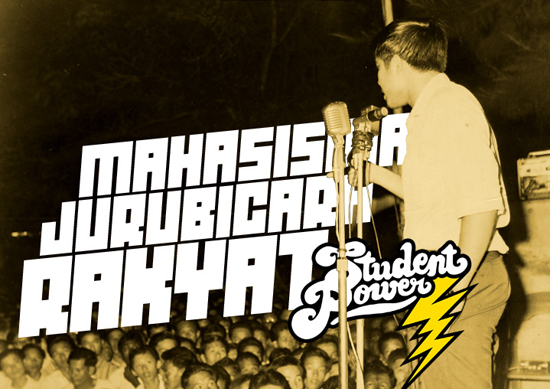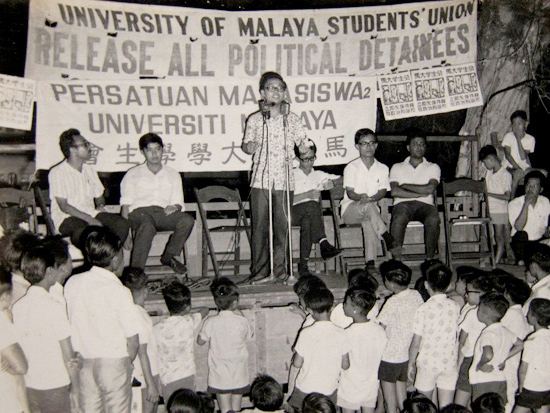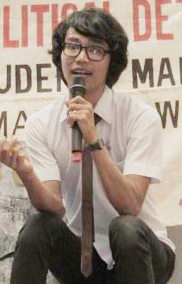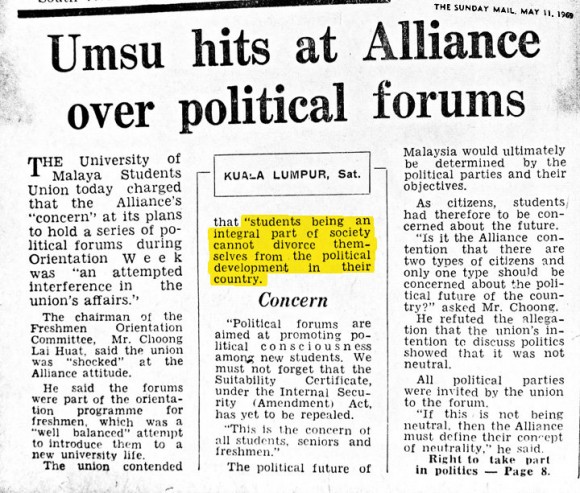By Gan Pei Ling | 17 August 2010 | The Nut Graph
IN the second of a two-part interview, self-taught people’s historian Fahmi Reza tells The Nut Graph more about the 1960s student movement, why their history has been under-documented, and what happened to it after its climax in 1969.
 TNG: Is there a particular reason why you named your lecture Student Power?
TNG: Is there a particular reason why you named your lecture Student Power?
Fahmi Reza: Yes, Student Power means “mahasiswa ada kuasa dalam pentadbiran universiti”. The students knew [and asserted] their rights in the 1960s and demanded for the democratisation of university.
You see, near the end of the 1960s, the university management was still divorced from the students. So even though the students were the majority in campus, they had no voice in the university’s running. That’s why they started pushing for representation and participation in the decision-making process of the university – in the administration of residential colleges, faculties, the library, and later at the highest level of university administration, the University Council and Senate.
The students fought for real student power back then. And I think this has always been the case with rights – if you don’t push and demand for it, the people in power are not going to give it to you for free.
Were the majority of university students active in the movement in the 1960s?
In any student movement, only around 5% will be the activists at the forefront. The difference is whether you have the critical mass to back your movement. Key student activists like Khong (Kim Hoong) and Syed Hamid Ali were, of course, more active than the rest of the student body. But they had the majority support of the students.
Even though the majority were not be at the forefront of the movement, they would still join in if there were demonstrations against injustice.
And bear in mind, these students were not blind followers. The students’ political consciousness was higher back then. They knew about the issues, and they were informed and exposed to different perspectives and ideas through the speaker’s corner, political forums, student newspapers, etc.
 It seems the student movement was really quite radical and influential in those days, but their history is somehow under-documented?
It seems the student movement was really quite radical and influential in those days, but their history is somehow under-documented?
Unfortunately, most of the student activists from the 1960s are not writing about their experience. [I also noticed that] the student movement’s history was omitted from (Tan Sri Prof Emeritus Dr) Khoo Kay Kim’s book 100 years the University of Malaya (2005) on UM’s history. Even though he was teaching history in UM in the 1960s and 1970s and he knew what happened, he didn’t mention the student movement in his book at all.
When I confronted him about it, he said the students didn’t do anything significant, that they were just a bunch of left-wing troublemakers. People always think historians were or should be neutral, but clearly they’re not. [Some of them only] look at history from above, from the ruler’s point of view. I’m more interested to look at history from below, from the people’s and students’ perspectives.
So I’m doing what I can to document these stories [of the student movement] before they are lost. The movement’s history and tradition are actually very rich, and I think the students deserve to know that, because it’s part of their history.
We once had a student movement that was politically conscious and alive and kicking in the 1960s. What happened to it in the 1970s?
UM was set up by the British in 1949 during the colonial days, so it followed the established Western university system and tradition. Education was left in the hands of educators. The government didn’t interfere with university administration, and the university administration didn’t interfere with student affairs. So the students enjoyed a lot of freedom and autonomy back then.
However, when the students started taking up issues outside campus, like when they held protests and stood up for the poor Malay peasantry and took part in the 1969 general election, the government began to feel threatened.
Also, the 1960s was a period of student uprising all over the world, and at the forefront were left-wing student leaders and organisations. In Paris during May 1968, students joined forces with workers and trade unions in the largest hartal (strike) in history that brought Paris to a standstill. They almost toppled the oppressive right-wing French government under General De Gaulle. In the US and Europe, students led protests against the Vietnam War. The power of these worldwide student movements was real. I’m sure the Malaysian government realised it.
So the government responded by enacting Auku (Universities and University Colleges Act 1971) to curb the autonomy of the students union and the power of the student movement. But of course, the students resisted. There was a clause in Auku that said exemption could be given by the (Yang di-Pertuan) Agong to certain universities. So Umsu (University of Malaya Students’ Union) fought for it and was exempted from Auku’s claws.
When the students took up the issue of poor Malay peasantry again in 1974, the government felt seriously threatened. So they banned Umsu, the Socialist Club in UM, and the National Union of Malaysian Students. They replaced powerful student unions like Umsu with the [comparatively] inferior students’ representative council (Majlis Perwakilan Pelajar), [which practically] had no power, no say, no independence or autonomy to handle students’ affairs. Badan Hal Ehwal Pelajar (Student Affairs Department) was set up and university administrators took over students’ affairs.
 Reflecting on the current situation of student activism in Malaysia, do you think there will be a time when the student movement becomes as, if not more, vibrant as it was in the 1960s?
Reflecting on the current situation of student activism in Malaysia, do you think there will be a time when the student movement becomes as, if not more, vibrant as it was in the 1960s?
Yes, if the students want it. I see change coming from below; it’s all about building a critical mass.
If the students were aware [of the freedom and autonomy their predecessors in the 1960s enjoyed], would they choose the present system, or would they choose what the students used to have in the 1960s? Which one would you choose?
IN the second of a two-part interview, self-taught people’s historian Fahmi Reza tells The Nut Graph more about the 1960s student movement, why their history has been under-documented, and what happened to it after its climax in 1969.

(All images courtesy of Fahmi Reza)
Fahmi Reza: Yes, Student Power means “mahasiswa ada kuasa dalam pentadbiran universiti”. The students knew [and asserted] their rights in the 1960s and demanded for the democratisation of university.
You see, near the end of the 1960s, the university management was still divorced from the students. So even though the students were the majority in campus, they had no voice in the university’s running. That’s why they started pushing for representation and participation in the decision-making process of the university – in the administration of residential colleges, faculties, the library, and later at the highest level of university administration, the University Council and Senate.
The students fought for real student power back then. And I think this has always been the case with rights – if you don’t push and demand for it, the people in power are not going to give it to you for free.
Were the majority of university students active in the movement in the 1960s?
In any student movement, only around 5% will be the activists at the forefront. The difference is whether you have the critical mass to back your movement. Key student activists like Khong (Kim Hoong) and Syed Hamid Ali were, of course, more active than the rest of the student body. But they had the majority support of the students.
Even though the majority were not be at the forefront of the movement, they would still join in if there were demonstrations against injustice.
And bear in mind, these students were not blind followers. The students’ political consciousness was higher back then. They knew about the issues, and they were informed and exposed to different perspectives and ideas through the speaker’s corner, political forums, student newspapers, etc.

The student activists employed a multilingual strategy in their election rallies: Syed Hamid Ali would speak in Bahasa Malaysia, Khong Kim Hoong in English, Yoong Suan in Mandarin, Chong Lai Huat in Hokkien, and Justin Chang in Cantonese. Rex Michael wasn't at all the rallies, but whenever he was present, he would speak in Tamil
Unfortunately, most of the student activists from the 1960s are not writing about their experience. [I also noticed that] the student movement’s history was omitted from (Tan Sri Prof Emeritus Dr) Khoo Kay Kim’s book 100 years the University of Malaya (2005) on UM’s history. Even though he was teaching history in UM in the 1960s and 1970s and he knew what happened, he didn’t mention the student movement in his book at all.
When I confronted him about it, he said the students didn’t do anything significant, that they were just a bunch of left-wing troublemakers. People always think historians were or should be neutral, but clearly they’re not. [Some of them only] look at history from above, from the ruler’s point of view. I’m more interested to look at history from below, from the people’s and students’ perspectives.
So I’m doing what I can to document these stories [of the student movement] before they are lost. The movement’s history and tradition are actually very rich, and I think the students deserve to know that, because it’s part of their history.
We once had a student movement that was politically conscious and alive and kicking in the 1960s. What happened to it in the 1970s?
UM was set up by the British in 1949 during the colonial days, so it followed the established Western university system and tradition. Education was left in the hands of educators. The government didn’t interfere with university administration, and the university administration didn’t interfere with student affairs. So the students enjoyed a lot of freedom and autonomy back then.
However, when the students started taking up issues outside campus, like when they held protests and stood up for the poor Malay peasantry and took part in the 1969 general election, the government began to feel threatened.
Also, the 1960s was a period of student uprising all over the world, and at the forefront were left-wing student leaders and organisations. In Paris during May 1968, students joined forces with workers and trade unions in the largest hartal (strike) in history that brought Paris to a standstill. They almost toppled the oppressive right-wing French government under General De Gaulle. In the US and Europe, students led protests against the Vietnam War. The power of these worldwide student movements was real. I’m sure the Malaysian government realised it.
So the government responded by enacting Auku (Universities and University Colleges Act 1971) to curb the autonomy of the students union and the power of the student movement. But of course, the students resisted. There was a clause in Auku that said exemption could be given by the (Yang di-Pertuan) Agong to certain universities. So Umsu (University of Malaya Students’ Union) fought for it and was exempted from Auku’s claws.
When the students took up the issue of poor Malay peasantry again in 1974, the government felt seriously threatened. So they banned Umsu, the Socialist Club in UM, and the National Union of Malaysian Students. They replaced powerful student unions like Umsu with the [comparatively] inferior students’ representative council (Majlis Perwakilan Pelajar), [which practically] had no power, no say, no independence or autonomy to handle students’ affairs. Badan Hal Ehwal Pelajar (Student Affairs Department) was set up and university administrators took over students’ affairs.

Fahmi
Yes, if the students want it. I see change coming from below; it’s all about building a critical mass.
If the students were aware [of the freedom and autonomy their predecessors in the 1960s enjoyed], would they choose the present system, or would they choose what the students used to have in the 1960s? Which one would you choose?


No comments:
Post a Comment